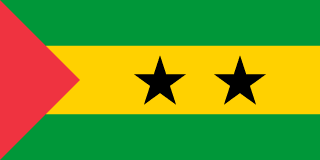São Tomé and Príncipe - Geography

Here, let us take a look at the Geography of São Tomé and Príncipe. The second-smallest African country (after the Seychelles); the two main islands form part of a chain of extinct volcanoes, and both are mountainous. Mother's mean age at first birth is 19.4 years (2008/09 est.) (Note: data represents median age at first birth among women 25-29), whereas, the Maternal mortality ratio is 146 deaths/100,000 live births (2020 est.)
Geographical data of São Tomé and Príncipe
| Location | Central Africa, islands in the Gulf of Guinea, just north of the Equator, west of Gabon |
|---|---|
| Geographic coordinates | 1 00 N, 7 00 E |
| Map references | Africa |
| Tarrain | volcanic, mountainous |
| Natural Resources | fish, hydropower |
| Natural Hazards | flooding |
| Irrigated Land | 100 sq km (2012) |
| Major rivers (by length in km) | |
| Major aquifers | |
| Land Boundaries | 0 km |
| Border Countries | |
| Coastline | 209 km |
| Climate | tropical; hot, humid; one rainy season (October to May) |
| Area | |
| Total Area | |
| Land Area | 964 sq km |
| Water Area | 0 sq km |
| comparative Area | more than five times the size of Washington, D.C. |
| Maritime Claims | |
| Territorial sea | 12 nm |
| Exclusive economic zone | 200 nm |
| Elevations | |
| Highest point | Pico de Sao Tome 2,024 m |
| Lowest point | Atlantic Ocean 0 m |
| Land Use | |
| Agricultural land | 44.8% (2022 est.) |
| Agricultural land: arable land | arable land: 4.2% (2022 est.) |
| Agricultural land: permanent crops | permanent crops: 39.6% (2022 est.) |
| Agricultural land: permanent pasture | permanent pasture: 1% (2022 est.) |
| Forest | 52.8% (2022 est.) |
| Other | 2.4% (2022 est.) |
Population Distribution
Sao Tome, the capital city, has roughly a quarter of the nation's population; Santo Antonio is the largest town on Principe; the northern areas of both islands have the highest population densities as shown in this population distribution map
People and Society
In São Tomé and Príncipe, the different Ethnic groups are such that we have: Mestico, Angolares (descendants of Angolan slaves), Forros (descendants of freed slaves), Servicais (contract laborers from Angola, Mozambique, and Cabo Verde), Tongas (children of servicais born on the islands), Europeans (primarily Portuguese), Asians (mostly Chinese)
| Population | |
|---|---|
| Pop growth rate | 1.42% (2024 est.) |
| Birth rate | 26.7 births/1,000 population (2024 est.) |
| Death rate | 6 deaths/1,000 population (2024 est.) |
| Health expenditure | 7.8% of GDP (2021) |
| Physicians Density | |
| Hospital bed Density | 2.9 beds/1,000 population (2011) |
| Total fertility rate | 3.31 children born/woman (2024 est.) |
| Gross reproduction rate | 1.63 (2024 est.) |
| Contraceptive prevalence rate | 49.7% (2019) |
| Est married women (ages 15-49) | 51.9% (2023 est.) |
| Literacy | age 15 and over can read and write |
| Education expenditures | 5% of GDP (2020 est.) |
| Net Migration rate | -6.5 migrant(s)/1,000 population (2024 est.) |
| Nationality | Sao Tomean | Sao Tomean(s) |
| Languages | Portuguese 98.4% (official), Forro 36.2%, Cabo Verdian 8.5%, French 6.8%, Angolar 6.6%, English 4.9%, Lunguie 1%, other (including sign language) 2.4%; other Portuguese-based Creoles are also spoken (2012 est.) |
| Religions | Catholic 55.7%, Adventist 4.1%, Assembly of God 3.4%, New Apostolic 2.9%, Mana 2.3%, Universal Kingdom of God 2%, Jehovah's Witness 1.2%, other 6.2%, none 21.2%, unspecified 1% (2012 est.) |
| Age Structure | |
| 0-14 years | 36.4% (male 41,337/female 40,106) |
| 15-64 years | 60.3% (male 67,101/female 67,775) |
| 65 years and over | 3.2% (2024 est.) (male 3,115/female 4,127) |
| Dependency Ratios | |
| Total dependency ratio | 77.9 |
| Youth dependency ratio | 71.2 |
| Elderly dependency ratio | 6.7 |
| Potential support ratio | 14.9 (2021 est.) |
| Median Age | |
| Total | 20.8 years (2024 est.) |
| Male | 20.4 years |
| Female | 21.2 years |
| Urbanization | |
| Urban population | 76.4% of total population (2023) |
| Rate of urbanization | 2.96% annual rate of change (2020-25 est.) |
| Major urban areas (Pop) | 80,000 SAO TOME (capital) (2018). |
| Sex Ratio | |
| At birth | 1.03 male(s)/female |
| 0-14 years | 1.03 male(s)/female |
| 15-64 years | 0.99 male(s)/female |
| 65 years and over | 0.75 male(s)/female |
| Total population | 1 male(s)/female (2024 est.) |
| Infant Motality | |
| Total | 42.6 deaths/1,000 live births (2024 est.) |
| Male | 46.1 deaths/1,000 live births |
| Female | 39 deaths/1,000 live births |
| Life Expectancy at birth | |
| Total population | 67.7 years (2024 est.) |
| Male | 66 years |
| Female | 69.4 years |
| Drinking Water Sources | |
| Improved: urban | urban: 100% of population |
| Improved: rural | rural: 94% of population |
| Improved: total | total: 98.5% of population |
| Unimproved: urban | urban: 0% of population |
| Unimproved: rural | rural: 6% of population |
| Unimproved: total | total: 1.5% of population (2020 est.) |
| Sanitation facility acess | |
| Improved: urban | urban: 57.1% of population |
| Improved: rural | rural: 42.8% of population |
| Improved: total | total: 53.4% of population |
| Unimproved: urban | urban: 42.9% of population |
| Unimproved: rural | rural: 57.2% of population |
| Unimproved: total | total: 46.6% of population (2020 est.) |
| Alcohol consumption per capita | |
| Total | 4.23 liters of pure alcohol (2019 est.) |
| Beer | 0.42 liters of pure alcohol (2019 est.) |
| Wine | 3.58 liters of pure alcohol (2019 est.) |
| Spirits | 0.23 liters of pure alcohol (2019 est.) |
| Other alcohols | 0 liters of pure alcohol (2019 est.) |
| Tobacco use | |
| Total | 5.7% (2020 est.) |
| Male | 10.1% (2020 est.) |
| Female | 1.3% (2020 est.) |
| Child marriage | |
| Women married by age 15 | 5.4% |
| Women married by age 18 | 28% |
| Men married by age 18 | 3.1% (2019 est.) |
Demographic profile
All Important Facts about São Tomé and Príncipe
Want to know more about São Tomé and Príncipe? Check all different factbooks for São Tomé and Príncipe below.
-
 São Tomé and Príncipe Factbook
São Tomé and Príncipe Factbook
-
 The Economy of São Tomé and Príncipe
The Economy of São Tomé and Príncipe
-
 Learn about the Government of São Tomé and Príncipe
Learn about the Government of São Tomé and Príncipe
-
 Communication in São Tomé and Príncipe
Communication in São Tomé and Príncipe
-
 Popular Universities in São Tomé and Príncipe
Popular Universities in São Tomé and Príncipe
-
 Enerny in São Tomé and Príncipe
Enerny in São Tomé and Príncipe
-
 Transport in São Tomé and Príncipe
Transport in São Tomé and Príncipe
-
 The Geography and society of São Tomé and Príncipe
The Geography and society of São Tomé and Príncipe
-
 The Environment of São Tomé and Príncipe
The Environment of São Tomé and Príncipe
-
 Military and security in São Tomé and Príncipe
Military and security in São Tomé and Príncipe